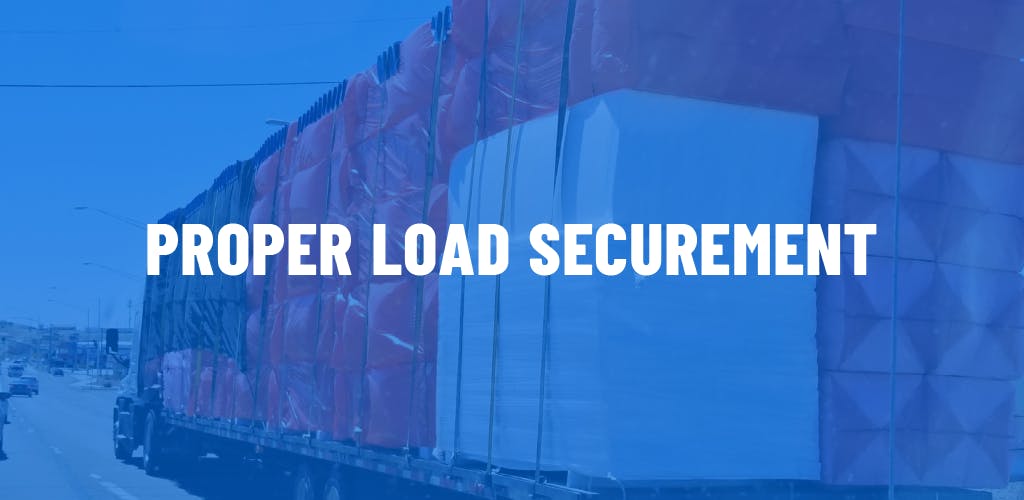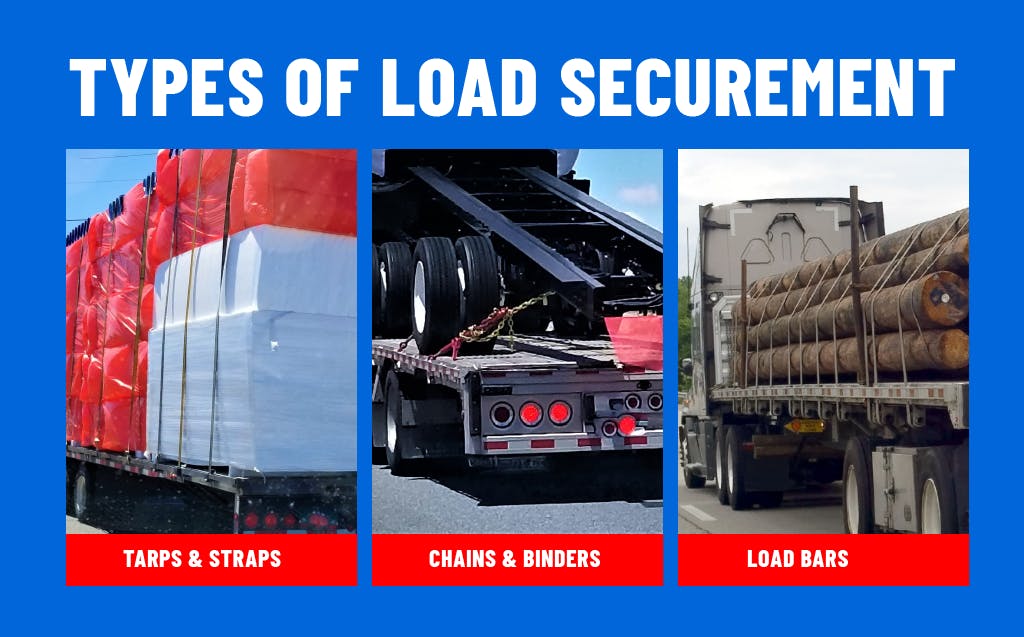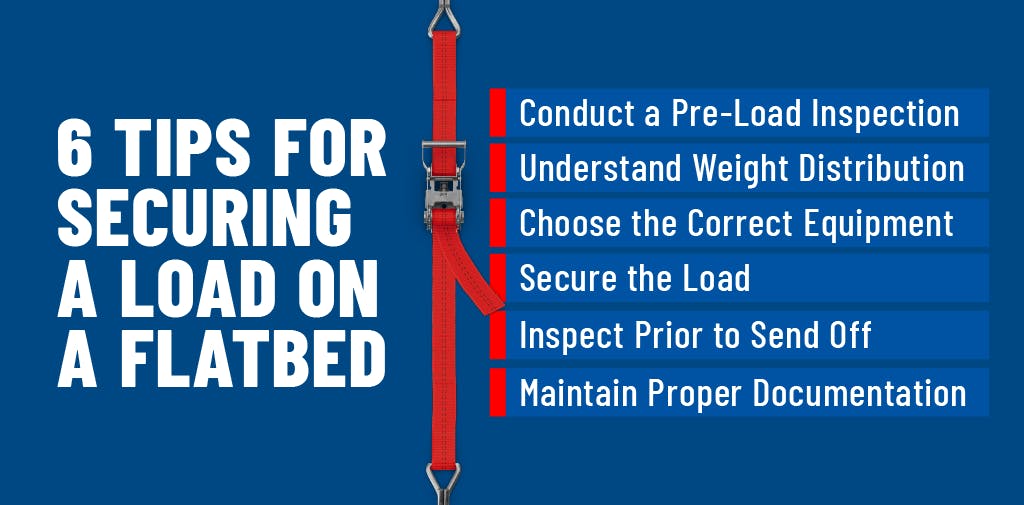Guide to Proper Flatbed Load Securement
March 14th, 2023

Poor load securement is one of several factors that contribute to truck accidents. Sometimes the load distribution is off, and one sharp turn can lead to an accident.
Flatbeds already take a particular level of skill to master for a safe journey on the road. It’s crucial for you to follow flatbed securement guidelines to be aligned with federal DOT regulations. You can use these defined rules as a guide for securing loads on trailers.
We will break down how to secure a load on a flatbed to prevent you from experiencing any incidents caused by improper load securement.
Let’s get you and your cargo ready for a safe haul.
What is Proper Load Securement
Proper load securement is a safety procedure that ensures that cargo loads are restrained to prevent loss of load and cargo shifting during transit.
The goal of securing loads on trailers is to prevent the load from shifting during transit, which can cause damage to both the truck and its contents. If you’re transporting sensitive goods—such as chemicals or food—it’s even more important that your cargo stays safe. You don’t want to pose a threat to anyone on the road from a securement mistake that could have been avoided.
Flatbed Securement Guidelines and Regulations
The Federal Motor Carrier Safety Administration (FMCSA) has securement rules for commercial vehicles reflecting best practices for flatbed load securement. To keep the FMCSA’s safety standards, they drive home the point of firmly securing your load with approved cargo securement equipment like chains, straps, and wire roping.
Regulations vary from state to federal level, so it’s important to check the rules before hitting the road with your load. However, there are some general guidelines that apply across the board:
- Make sure that all cargo is securely fastened to the bed of your vehicle.
- Use straps and chains when necessary.
- Check all connections before departure.
Types of Load Securement
There are several types of load securement for a flatbed truck. Let’s look at the most common types of flatbed load securement and their advantages:

Tarps and Straps
Straps are hooked to the ICC bar that runs along the trailer’s edge and thrown over the load to secure the cargo/cargo and tarp before being locked in a winch with a winch bar. This is so the cargo does not shift around. Most commonly used are the 4-inch straps which can support up to about 5,500 lbs.
Tarps are used for securing loads on trailers as covers affixed with straps or other securement methods. They protect the cargo from outside elements and assist with helping merchandise not blow away. To be in compliance with various state and federal laws, be sure to review tarping requirements.
Chains and Binders
Heavy loads that are typically coils of aluminum and steel, as well as farm equipment, will be secured with chains and binders. Each chain can be linked to the load or into ICC Bar. The chain is then stretched taut, and a binder is applied to tighten it.
Depending on the dimensions and weight of the cargo, there will be a certain chain to accommodate securing loads on trailers. Chains and binders can be used together or separately to prevent cargo shifting during transport.
Load Bars
Load bars help distribute the weight of your cargo across a larger surface area, which means you can haul more without the risk of damaging your truck or trailer. Using load bars on flatbed trailers is a cost-effective and efficient way to transport heavy loads.
6 Tips on How to Secure a Load on a Flatbed
As a truck driver or fleet owner, it’s important to be educated on how to secure a load on a flatbed. The main thing to note is that the cargo must be immobilized, but different cargo rules apply in certain situations.
Every time you prepare to hit the road, you should follow these 6 tips for securing loads on trailers:

1. Conduct a Pre-Load Inspection
Take about 30 minutes to check the condition of your trailer, equipment, and load. Be sure nothing’s shifted and that the weight is still distributed evenly to avoid unintentionally swerving or tipping over. This time is crucial to catch any issues that may contribute to the delay or safety of your shipment.
2. Understand Weight Distribution
Understand how the weight distribution and dimensions of a flatbed trailer affect each other. These factors need to work together for the stability of the cargo on the flatbed. When the standard freight weight that can be supported is around 48,000 pounds, calculating weight is a key step in load securement. Based on the placement of cargo, it will need to be distributed evenly and secured with the correct equipment FMCSA requires.
3. Choose the Correct Type of Equipment
The correct securement device is mostly determined by the cargo. When your rig is moving, chain and binders, straps, load bars keep freight secure in position. For example, straps are a better alternative for softer materials such as lumber or plastic piping. They are easily damaged and should be thoroughly checked before each usage.
This is why you can’t assume all is fine. Making sure everything is still anchored after every 50 miles you drive is a good practice to add to your routine.
4. Secure the Load
With your load securement equipment, know how much weight each can support. The FMCSA requires at least one tiedown for every ten feet of cargo and any fraction in excess of that. For example, 35-foot-long freight needs four tiedowns.
5. Inspect Load Securement Prior to Send Off
Before you pull off, you should check for any damages or defects in your equipment and cargo. Even if it seems minor, it will lessen the blow or avoid an incident altogether. Equipment can lose its effectiveness along the way per haul, so an inspection is a good practice to put in place.
6. Maintain Proper Documentation for Future Loads
Maintain inventory and the condition of your equipment. If you keep a running list of pre-load inspections and other procedures, you’ll know when a strap needs to be replaced, or if you should invest in other equipment like corner protectors for straps to extend their life. Getting a feel for what to expect per load will give you peace of mind while hauling.
The Importance of Proper Load Securement for Flatbeds
Flatbed load securement is a little different from the proper reefer loading. There are rules and standards that are key like ensuring cargo does not:
- Blow, tumble, or detach from the vehicle
- Leak
- Shift and jeopardize vehicle stability or performance
Prepare ahead of time, make sure you have enough tools to do the task correctly, and inspect it frequently. You’ll be able to make your shipment safely and without damaging the cargo in the process. A well-secured load with good equipment will keep everyone safe and save you a lot of trouble on the road.
Frequently Asked Questions
How Do You Keep a Trailer From Tipping When Loading?
First, make sure that the trailer is level while loading. If it’s not, you’ll run the risk of putting too much weight in one spot and causing the trailer to tip over. It’s also a good idea to put heavier items near the center of the trailer, where they will have less leverage on their sides. This will make for even distribution of weight.
Depending on the weight and cargo, determine if the flexibility of LTL and FTL freight options may work better for you.
Are Ratchet Straps DOT Approved?
Yes, ratchet straps are DOT-approved. All tie-downs need to be free of knots and repaired in a DOT-approved manner.
How Many Tie-Downs Do You Need for a Flatbed Load?
For every 10,000 pounds, you need four tightening devices being tie-downs. Straps are highly recommended and common because of the amount of weight they can support without damaging cargo.
Secure Your Load with Hale Trailer
At Hale Trailer, we will make sure you get flatbed load securement down to a science. Drivers can ensure they tighten their load before their haul with security in knowing they’re traveling safely.
Hale Trailer has the experience to give you tips on how to secure a load on a flatbed. We have worked hard to maintain a sizeable inventory from flatbeds for rent to load securement equipment. Stop by one of our semi-trailer locations if you’re interested in renting or buying a flatbed trailer. Our selection can also be found online. Contact us to learn more about how we can work to meet your trucking needs.
All the information on this website – https://www.haletrailer.com – is published in good faith and for general information purposes only. Hale Trailer Brake and Wheel does not make any warranties about the completeness, reliability and accuracy of this information. Any action you take upon the information you find on this website, is strictly at your own risk. Hale Trailer Brake and Wheel will not be liable for any losses and/or damages in connection with the use of our website.
